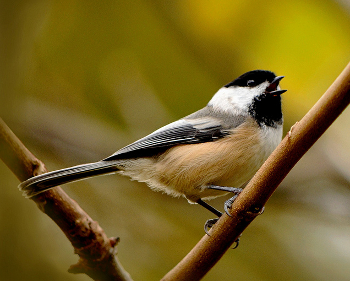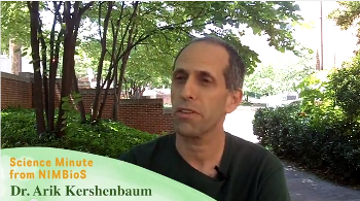The ABCs of Animal Speech: Not So Random After All
August 20, 2014

KNOXVILLE—The calls of many animals, from whales to wolves, might contain more language-like structure than previously thought, according to a study that raises new questions about the evolutionary origins of human language.
The study, published today in the journal Proceedings of the Royal Society B, analyzed the vocal sequences of seven different species of birds and mammals and found that the vocal sequences produced by the animals appear to be generated by complex statistical processes, more akin to human language.
Many species of animals produce complex vocalizations—consider the mockingbird, for example, which can mimic over 100 distinct song types of different species, or the rock hyrax, whose long string of wails, chucks and snorts signify male territory. But while the vocalizations suggest language-like characteristics, scientists have found it difficult to define and identify the complexity.
Typically, scientists have assumed that the sequence of animal calls is generated by a simple random process, called a "Markov process." Using the Markov process to examine animal vocalization means that the sequence of variables—in this case, the vocal elements—is dependent only on a finite number of preceding vocal elements, making the process fairly random and far different from the complexity inherent in human language.
Yet, assuming a Markov process exists raises questions about the evolutionary path of animal language to human language—if animal vocal sequences are Markovian, how did human language evolve so quickly from its animal origins?
Indeed, the study found no evidence for a Markovian process. The researchers used mathematical models to analyze the vocal sequences of chickadees, finches, bats, orangutans, killer whales, pilot whales and hyraxes, and found most of the vocal sequences were more consistent with statistical models that are more complex than Markov processes and more language-like.
Human language uses what's called "context-free grammars," whereby certain grammatical rules apply regardless of the context, whereas animal language uses simple or "regular" grammar, which is much more restrictive. The Markov process is the most common model used to examine animal vocal sequences, which assumes that a future occurrence of a vocal element is entirely determined by a finite number of past vocal occurrences.
The findings suggests there may be an intermediate step on the evolutionary path between the regular grammar of animal communication and the context-free grammar of human language that has not yet been identified and explored.
"Language is the biggest difference that separates humans from animals evolutionarily, but multiple studies are finding more and more stepping stones that seem to bridge this gap. Uncovering the process underlying vocal sequence generation in animals may be critical to our understanding of the origin of language," said lead author Arik Kershenbaum, a postdoctoral fellow at the National Institute for Mathematical and Biological Synthesis.
Citation: Kershenbaum A, Bowles A, Freeburg T, Dezhe J, Lameira A, Bohn K. 2014. Animal vocal sequences: Not the Markov chains we thought they were. Proceedings of the Royal Society B. [Online]
Media Coverage Highlights
Science:
Animal speech shows similarities to human language
Washington Post:
Chirps, whistles, clicks: Do any animals have a true 'language'?
BBC Radio 5:
Arik Kershenbaum interview
Daily Mail:
How animals chew the fat just like us: Howls, croaks and chirps are 'just as complex as human speech'
Sydney Morning Herald:
If animals could talk...Or do they?
French Tribune:
Researchers find more patterns in animal speech
Evening Telegraph:
Animal calls 'more like language'
Morning Star:
Animal noises 'more closely linked' with human speech
Irish Independent:
Animal calls 'more like language'
Austrian Tribune:
Vocal sequences of animals are akin to human language
Times of India:
Animal calls more like language: Study
News Tonight Africa:
Many animals make sounds more like human language: Study
#
The National Institute for Mathematical and Biological Synthesis is an NSF-supported center that brings together researchers from around the world to collaborate across disciplinary boundaries to investigate solutions to basic and applied problems in the life sciences. NIMBioS is supported by the National Science Foundation, the U.S. Department of Homeland Security, and the U.S. Department of Agriculture with additional support from The University of Tennessee, Knoxville.
CONTACT:
Catherine Crawley, NIMBioS – (865) 974-9350 ccrawley@nimbios.org
Arik Kershenbaum (arik@nimbios.org)
NIMBioS
1122 Volunteer Blvd., Suite 106
University of Tennessee
Knoxville,
TN 37996-3410
PH: (865) 974-9334
FAX: (865) 974-9461
Contact NIMBioS



